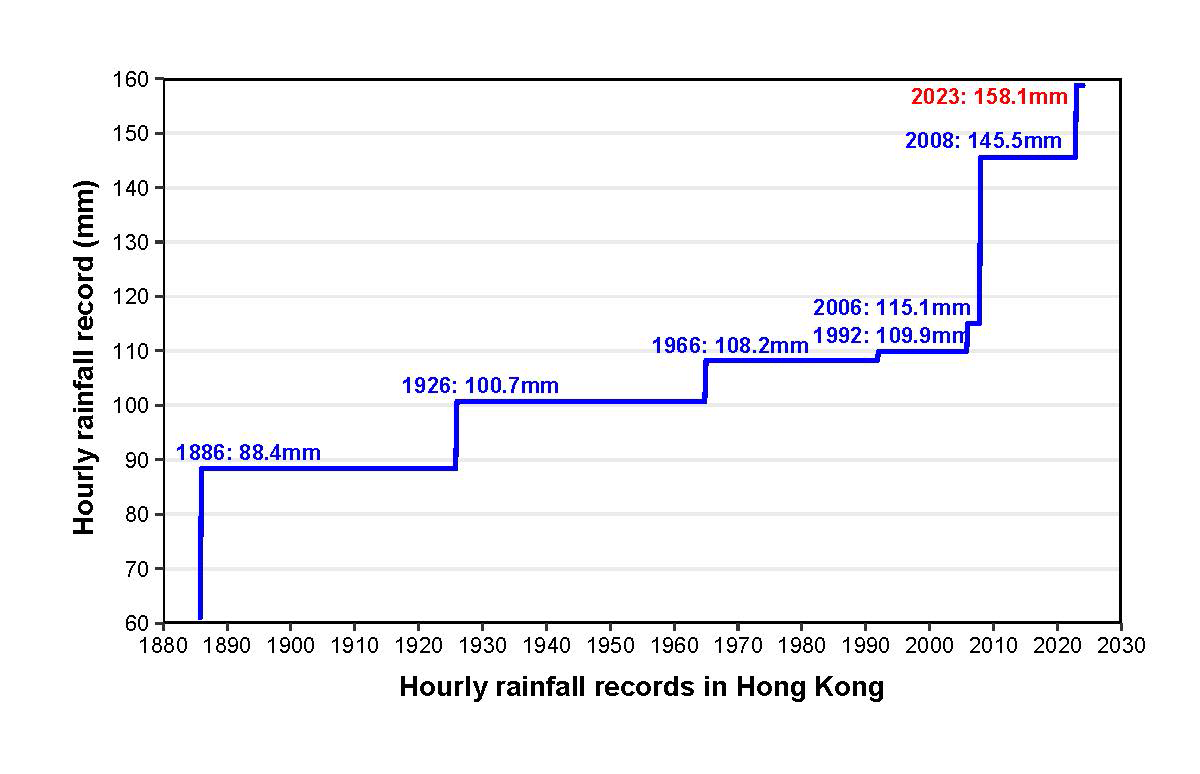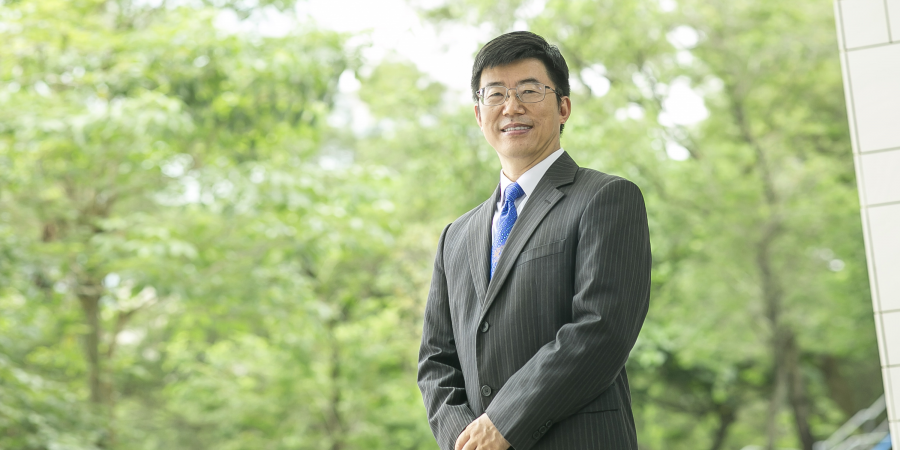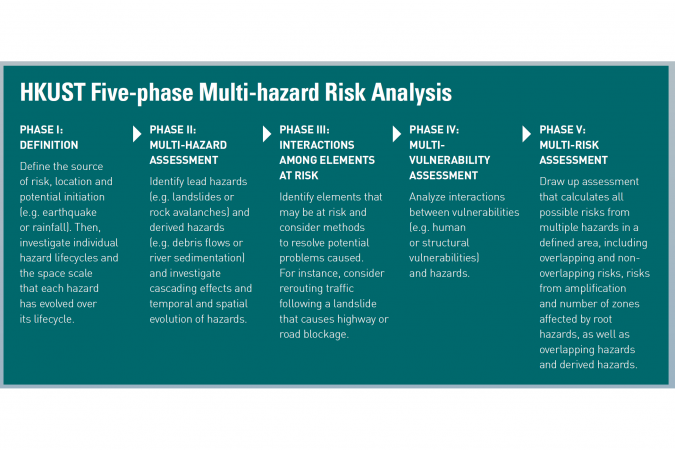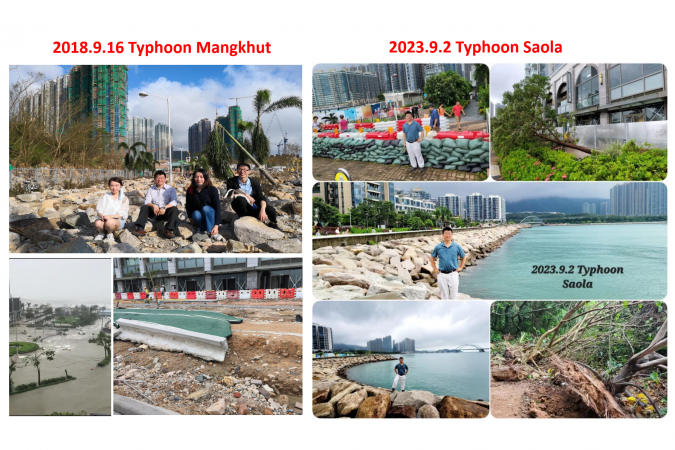Digitalizing Disasters to Counter Climate Change
In the face of increasing extreme rainfall events that often trigger further dangers, School of Engineering civil engineers are setting out to develop a pioneering city-scale slope digital twin to boost forecasting, prevention, and mitigation of Hong Kong’s number one natural hazard: landslides.
In early September, Hong Kong experienced its worst flooding for centuries as the last vestiges of Typhoon Haikui swept into the city bringing with them an unprecedented 16-hour black rainstorm alert. Around 600mm of rainfall fell over a 24-hour period, equating to one-quarter of the city’s usual annual total, according to the Hong Kong Observatory. On the southside of Hong Kong Island, it even exceeded 800mm. The weather monitoring body and forecaster also recorded record-breaking hourly rainfall at its headquarters, reaching as high as 158mm at one point.
There were two fatalities and over 140 people sought hospital treatment. The torrential downpours disrupted roads and MTR subway lines, and caused damage to buildings. Of further major concern, over 190 landslides – Hong Kong’s primary natural hazard – were reported, cutting off areas such as Shek O village and causing extensive damage to homes on Redhill Peninsula on Hong Kong Island. However, there were no deaths from the landslides despite Hong Kong’ s densely populated coastal and hilly terrain. And looking at the scale of incidents overall, Prof. ZHANG Limin, a geotechnical specialist in multi-hazard risk management (“where one trigger can cause a lot of hazards”), was quietly relieved. To Prof. Zhang, Head of Department and Chair Professor in Civil and Environmental Engineering, the outcome was an indication that the city’s disaster mitigation measures for flooding and associated landslide risks are having an impact.
In contrast, Prof. Zhang pointed out, the earthquake that happened shortly afterward in Morocco and the torrential rains triggering dam bursts in Libya saw thousands lose their lives and damage so extensive that international emergency assistance had to be requested. Moreover, the after-effects are on-going, with potential disease a major risk and reconstruction amounting to billions of US dollars. In Hong Kong, the day after the major downpour, the city swung back into action. Initial estimates put the cost at around US$100 million. “Though the storm in Libya was smaller than in Hong Kong, you can see the huge difference in the consequences due to preparedness and emergency management,” he said.
Engineering the future, managing risk
Nevertheless, the unexpectedness of the Haikui-related rainstorm, deaths, and deluge of criticism on preparedness that followed showed there is still much more to be done. And as a core member of HKUST’s world-renowned geotechnical research team for close to 25 years, Prof. Zhang is about to contribute, with his timely new research project focused on “Digital Twin-empowered Landslide Emergency Risk Management” that starts in January 2024.
Prof. Zhang has already been heavily involved in driving forward natural disaster and risk management and mitigation methods in Hong Kong, Mainland China, and globally. He believes engineering should not only be concerned with resolving existing problems and improving what already exists. More importantly, it is about “foreseeing and solving future problems”. Which is why he has made multi-risk assessment, risk-based engineering design, and emergency management the focus of his work for the past 15 years, in the process helping to evolve the emerging science.
Looking at the interactions between the risks rather than as individual issues, he and his team have previously established a novel multi-hazard risk analysis framework known as the HKUST five-step method (see box at the end of article). He has worked extensively on risks related to soil mechanics together with his Civil Engineering senior colleague Prof. Charles NG Wang-Wai. Prof. Zhang has also investigated landslide hazard chains triggered by strong earthquakes and associated risk management.
In Hong Kong, the University’s geotechnical engineers often work closely with HKSAR Government departments on a variety of pioneering preventative and mitigation projects. Hong Kong has over 60,000 manmade slopes as well as natural terrain – much of it mountainous – covering 60% of the city’s total land area. While the last landslide-related fatalities occurred in 2008 when two people died on Lantau, some 300 landslides on average still occur annually in Hong Kong, according to the HKSAR Government’s Civil Engineering and Development Department. Moreover, as statistics indicate (see chart below) and the black rainstorm demonstrated, extreme rainfall – one of the key triggers – is increasing in both intensity and frequency in Hong Kong.
Impact of climate change: extreme rainfall in Hong Kong

Increasing intensity and frequency of extreme rainfall in Hong Kong due to climate change. (Updated chart, based on original by Dr. C. T. Lee)
World-leading city-scale slope digital twin
Thus, in his “Digital Twin” project, Prof. Zhang is set to further assist policymakers and the community in better forecasting and emergency response, leveraging the data analysis and technological advances opened up by the digital era, in particular AI, remote sensing, and augmented/virtual reality. One project goal is to deliver the world’s first comprehensive and versatile city-scale slope digital twin to sense, simulate, and visualize landslide hazard processes in order to coordinate how to respond. Prof. Zhang is also seeking to create a new model for managing hazard emergency risks that covers the “human response” aspect of landslide emergency risk management. This will be achieved through devising a digital twin-empowered common operating platform with an augmented reality environment for interactive decision-making, emergency management, as well as immersive public education.
Fully Interactive City-scale Slope Digital Twin
The digital twin project is seeking to enhance the disaster resilience of existing slope safety systems in Hong Kong and other regions by establishing an intelligent sensing system that integrates air, space and ground to monitor surface conditions and social activities and quickly identify landslides.
The partners involved are a testament to HKUST’s local and international standing, comprising the Chinese University of Hong Kong, the University of Hong Kong, the government’s Civil Engineering and Development Department, the University of California, Berkeley, and the Norwegian Geotechnical Institute. Meanwhile, the scale and essential contribution that Prof. Zhang’s project is set to make to the community and internationally have been fully recognized with the awarding of HK$73.945 million* in Hong Kong’s prestigious Theme-based Research Scheme 2023/24, the highest funding among the nine projects approved for this round of the Research Grants Council scheme.
To implement the cutting-edge project, Prof. Zhang is bringing together a multinational, cross-disciplinary team including experts from his own field of geotechnical engineering, as well construction informatics, computer science, remote sensing, emergency management, and public policy, among others. Challenges include moving from project-scale to a city-scale interactive simulation-enabled digital twin, extending slope-scale computational capabilities to city-scale real-time modeling, and developing dynamic risk-informed decision theory in complex urban settings.
“Engineering works always have an important role to play in managing natural disasters and extreme weather events,” Prof. Zhang said. “But in addition we need to take into account the human response. Therefore the strategy should be not only to prepare to mitigate extreme events, but to have thought ahead to emergency risk management as well.”
Utilizing HKUST’s new eye in the sky
A pioneering addition to the project’s analytical tool kit to help with this is “HKUST-FYBB#1”, a multispectral optical satellite named for the University and the donor supporting the launch and successfully launched in August 2023 in Gansu Province. The first such university satellite mission in Hong Kong, the data provided will initially be used for the digital twin project, and later to build a remote sensing satellite constellation for environmental monitoring to meet China’s carbon goals as well as a disaster forecasting system.
HKUST-FYBB#1 is the most advanced civilian satellite of its kind, collecting remote sensing images with a spatial resolution of 0.5 meters, which is 20 times higher than open access images taken from the European Space Agency’s Sentinel-2 optical satellite, and an image width (horizontal distance) of 150 kilometers. The HKUST satellite started remitting images via its optical camera after just 1.5 hours’ flight time, Prof. Zhang said.
Watching HKUST-FYBB#1 sail into the sky at the launch ceremony along with around 50 HKUST alumni, students, and donors, Prof. Zhang Limin (right photo, second from right) experienced both anxiety over the launch’s success followed by excitement as the satellite rose and then soared into the sky. (Left photo credit: Chang Guang Satellite Technology Co. Ltd.)
“The project is both exciting and daunting,” Prof. Zhang said. “We can do really useful work, as the black rainstorm showed. But the storm also brought home the heavy responsibility and expectations involved, given the amount of media and University management enquiries about the project following the floods.”
Born to benefit society
However, taking on such a responsibility and contribution to society are both characteristic features of Prof. Zhang’s life. Growing up in a small town in Yunnan Province amid the country’s Cultural Revolution in the 1960s and 1970s, he was not given a formal name until he entered primary school. The name “Limin” eventually chosen by his family meant “benefiting the community”, which the hard-working youngster went on to actively live up to in the different circles he has moved in as an educator and researcher, in professional service to academia, and in wider society.
After high school, he spent his university student days in Sichuan, taking his bachelor, master, and doctoral degrees at Chengdu University of Science and Technology (now Sichuan University) before heading overseas in the mid-1990s. In 1995, he went to Karlsruhe University in Germany as a visiting scholar and then on to postdoctoral research at the University of Florida in the US. Going overseas was not difficult, he recalled. The Mainland by then was fully open and he had already written and defended his master’s degree in English while in Sichuan.
Milestone moves
It was during this time abroad that he became more familiar with centrifuges, large-scale advanced technical facilities for modeling and observing geotechnical problems. Such practical experience – “I was what is known as a ‘centrifuge rat’ always crawling through narrow spaces to prepare samples” – helped draw him to HKUST at the end of 1998 when the University was setting up its own world-leading centrifuge facility and where today he serves as director.
His move to hilly Hong Kong also spurred a milestone change in his geotechnical interests, moving his focus from bridge foundations and dams to landslides, in line with the city’s terrain and needs. Later in 2008, another turning point occurred when he helped oversee the rebuilding of a major Sichuan highway that the HKSAR Government was funding as part of relief efforts following the devastating 2008 Wenchuan earthquake. The disaster resulted in more than 200,000 landslides, and over the 10 highly challenging years it took to complete the road-building project, Prof. Zhang gained exposure to all aspects of landslide processes and their chain interaction with other hazards. In addition, he had to come up with solutions to prevent and mitigate future risks in order to keep the road open. Many of his PhD students graduated with their research based around the highway project. It was also a personally moving experience with his parents-in-law among those affected by the earthquake.
Indeed, Prof. Zhang credits the profound encounter in Sichuan with generating the insight that engineering needs to not only learn from the past but also predict the future. He identifies this as the greatest motivation for his move to multi-hazard and risk management research. It also spurred seminal contributions to the understanding of landslide hazard chains induced by earthquakes, pinpointed through extensive case histories of the 2008 Wenchuan earthquake and the subsequent 2014 Ludian earthquake in Yunnan Province. More recently, he has investigated mechanisms of mountain disasters on the east of Qinghai-Tibet Plateau.
Since turning to this research focus, he has published nearly 350 international journal papers and national and international honors have resulted. These include a 2019 Natural Science Award (First Class) in the Higher Education Outstanding Scientific Research Output Awards (Science and Technology) from the Ministry of Education and the Ralph B. Peck Award in 2023, presented by the American Society of Civil Engineers and regarded as one of the top global accolades in geotechnical engineering. But such eminence has not affected his outlook as an educator, and he remains keen to share his experiences and expertise with his postgraduate and undergraduate students. This has included advising the HKUST Wu Zhi Qiao Team of students, who set out to assist villagers in remote areas of the Mainland by initiating and constructing footbridges.
Accelerating to civil engineering 4.0
Meanwhile, as Head of the Civil and Environmental Engineering Department since 2021, Prof. Zhang has also been contributing to advancing the field as a whole. At HKUST, this encompasses research ranging from the geotechnical to hydraulics, environmental to construction management, structural and materials to smart city, and transportation, as well as degree programs from bachelor’s degrees to doctorates within a multicultural departmental community racing toward civil engineering 4.0.
He notes it is a particularly stimulating time to be leading the Department, given that the University’s strategic themes and Hong Kong’s goals both include clear visions for tackling climate change, energy resources, smart city development, and greater digitalization. Massive infrastructure projects being planned in Hong Kong, such as Lantau Tomorrow and the Northern Metropolis, will generate the need for civil engineering and environmental input. At the same time, support through research funding and faculty recruitment is bringing on-going renewal of talents and keeping the Department’s teaching and research environment vigorous through the introduction of new ideas, areas, and dynamics.
Prof. Zhang is particularly delighted at the success of younger colleagues in gaining highly competitive research funding. Recent rising-star awardees of RGC Collaborative Research Fund include: Prof. LU Mengqian, who is tackling infrastructure planning for sustainable water development in the Greater Bay Area amid climate uncertainties; Prof. WANG Zhe, investigating green roof systems, and Prof. Anthony LEUNG looking into tree responses and engineering of safer urban forests during typhoons. In another groundbreaking project, Prof. SU Hui, who joined the Department in 2022 from the NASA Jet Propulsion Laboratory, is leading the HKUST-FYBB#1 satellite research team.
What next?
For Prof. Zhang, the future looks to hold even more responsibilities with the digital twin project kicking off at the start of the new year. While he currently does not have the luxury of time for holidays or outside interests, he enjoys the travel he undertakes for his work, and continues to derive great satisfaction from being able to help people through what he does.
Moreover, he remains optimistic about the prospects for climate change and mitigation overall. “I don’t think it is ever too late. It is more a question of getting started.”
*Includes RGC funding and matching funds from the universities involved
Related link:
- SENG news (July 21, 2023): Project Led by Prof. ZHANG Limin Received HK$74 Million Funding under RGC Theme-based Research Scheme
- HKUST press release (Aug 26, 2023): HKUST Successfully Launches “HKUST-FYBB#1” Satellite
- SENG news (May 2, 2023): Prof. ZHANG Limin Named 2023 Winner of ASCE Ralph B. Peck Award
- SENG news (July 6, 2020): HKUST Engineering Received Three Outstanding Scientific Research Output Awards



